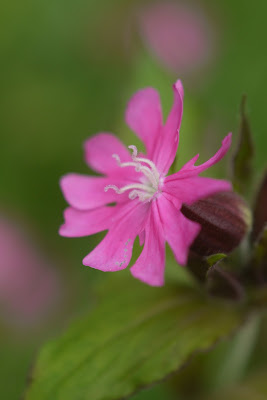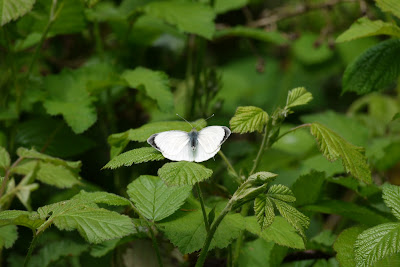- The Great Spotted Woodpecker nest I found last week is still going strong, with the young ones sounding even louder this week. I wonder when they will emerge from the nest hole? It'd be brilliant to see them enter the wider world for the first time but my timing would have to be pretty spectacular to coincide with that! I also saw an adult Great Spotted Woodpecker feeding in a slightly unorthodox fashion from the top of a tree - it was flycatching, chasing flies around in the air and picking them out to eat!
- The Grey Heron family is doing great, with all the youngsters now clearly fledged - they are flying about and exploring the site.
- The two families of Coots on Merecroft Pool now have one and two chicks each. The two chicks in particular were quite big and looking as though they will make it to adulthood now.
- Other juvenile birds seen around the site included Robin and Long-tailed Tit.
- I heard Whitethroat again in the same two places, along the Rea Valley path west of Wychall Reservoir, and in the Peafields/West Extension.
- I had really lovely views of a Nuthatch feeding on a tree trunk in the marshy area at the south end of Merecroft Pool.
- A Buzzard was being mobbed by Carrion Crows over the Paddocks.
- Some good butterfly sightings - I saw a couple of blue ones which I couldn't get a good enough look at to identify conclusively but I think were Holly Blue. Also saw Orange Tip, Large White, Green-veined White, Speckled Wood and possibly Small White, although again, I didn't quite get a good enough look to be sure.
 |
| British Waterways Meadow looking lush (HDR). |
 |
| The marshy area behind the Merecroft Pool dam (HDR). Lots of botanical interest here at the moment, and it smells minty-fresh due to all the mint growing there! |
 |
| The Peafields/West Extension (HDR). |
 |
| A big patch of Red Campion (Silene Dioica) which I needed to find for my Identiplant assignment! |
 |
| Male Red Campion (Silene Dioica) flowers. |
 |
| Male Red Campion (Silene Dioica) flower. |
 |
| Female Red Campion (Silene Dioica) flower. |
 |
| Orange Tip butterfly (Anthocharis cardamines). |
 |
| The Silverweed (Argentina anserina) is flowering! |
 |
| Buzzard and Carrion Crow argy-bargy. |
 |
| Yellow Iris (Iris pseudacorus). |
 |
| Bog Stitchwort (Stellaria alsine). |
 |
| I am trying to get better at grass identification. I think this one is Sweet Vernal Grass (Anthoxanum odoratum). It smells and tastes vaguely vanilla-ish! |
 |
| This was a new one to me. It had very fine delicate leaves compared to Cow Parsley, I think it is Pignut (Conopodium majus). |
 |
| Nuthatch. |
 |
| Large White butterfly (Pieris brassicae). |
| Blackbird | Goldcrest | Long-tailed Tit |
| Blackcap | Goldfinch | Magpie |
| Blue Tit | Great Spotted Woodpecker | Mallard |
| Buzzard | Great Tit | Nuthatch |
| Canada Goose | Greenfinch | Robin |
| Carrion Crow | Grey Heron | Song Thrush |
| Chaffinch | Herring Gull | Starling |
| Chiffchaff | House Sparrow | Stock Dove |
| Coot | Jackdaw | Whitethroat |
| Dunnock | Jay | Woodpigeon |
| Feral Pigeon | Lesser Black-backed Gull | Wren |






































